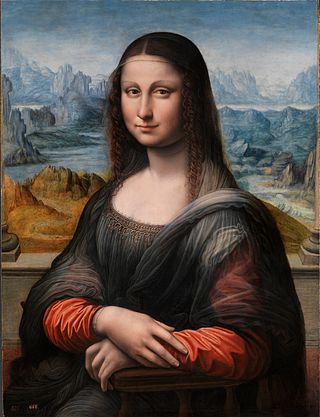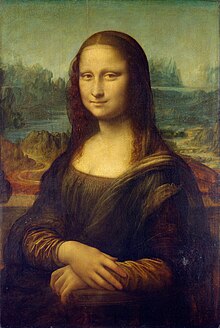| Prado Mona Lisa | |
|---|---|
 | |
| Artist | Workshop of Leonardo da Vinci |
| Year | c. 1503–1516 |
| Medium | Oil on walnut panel |
| Subject | Lisa Gherardini |
| Dimensions | 76.3 cm × 57 cm (30.0 in × 22 in) |
| Location | Museo del Prado, Madrid |
The Prado Mona Lisa is a painting by the workshop of Leonardo da Vinci and depicts the same subject and composition as Leonardo's better known Mona Lisa at the Louvre, Paris. The Prado Mona Lisa has been in the collection of the Museo del Prado in Madrid, Spain since 1819, but was considered for decades a relatively unimportant copy. Following its restoration in 2012, however, the Prado's Mona Lisa has come to be understood as the earliest known studio copy of Leonardo's masterpiece.

Although there are dozens of surviving copies of the Mona Lisa from the 16th and 17th centuries, the Prado's Mona Lisa may have been painted simultaneously by a student of Leonardo in the same studio where he painted his own Mona Lisa, so it is said to be the copy with the most historical value. Among the pupils of Leonardo, Salaì or Francesco Melzi are the most plausible authors of the Prado's version, though other experts argue that the painting could have been executed by one of Leonardo's Spanish students.
Background
Main article: Mona LisaThe origins of the Prado's Mona Lisa are linked to those of Leonardo's original, as both paintings were likely created simultaneously in the same studio. The first documentary reference was made in the 1666 inventory in the Galleria del Mediodia of the Alcazar in Madrid as Mujer de mano de Leonardo Abince (Woman by Leonardo da Vinci's hand). However, it is still unknown when the portrait entered the Spanish Royal Collection, though it could have been already in Spain in the early years of the 17th century. Since the Prado's founding in 1819, the copy has been part of its permanent collection.
Restoration

Previous to its restoration, the painting was catalogued as an anonymous copy from the first quarter of the 16th century. However, it usually hung in the Prado alongside masterpieces of Italian artists such as Raphael or Andrea del Sarto. A lithograph of the painting also exists, which is unusual for an anonymous copy.
Although there were elements that clearly distinguished the copy from the Louvre's version, the most striking point was the fact that until the restoration of the Prado's version, no landscape background was visible. That landscape was fully recovered through the restoration carried out by the Prado between 2011 and 2012, for a request to include the Prado's work in a temporary exhibition in the Louvre called Leonardo's last masterpiece: The Sainte Anne, from 29 March to 25 June 2012. The oxidized varnishes indicated that the black repaint had been made 200 years after the copy was painted, that is to say, not before 1750.
During this restoration process, the copy was also submitted to a study of infrared reflectography and radiography, where the results revealed that the painting had been made in the workshop of Leonardo da Vinci at the same time the original Mona Lisa was painted. The "key" of this discovery was the underlying drawing, as it is the same but with different style in both paintings, as well as the drawing's corrections.
These findings, coupled with the excellent state of preservation in regard to the Louvre's version, show the original colours of the Prado's painting and indicates what the copy must have originally looked like, as the varnish on the original has become cracked and yellowed with age. It is anticipated that such revelations also may offer further insight into Leonardo's original.
The suggestion that the Prado version was painted in the workshop of Leonardo at the same time as the Louvre version, presumably by an apprentice, is supported by the observation that it appears to have been rendered from a slightly different perspective than the original. This has fuelled speculation that the pair may constitute the world’s first stereoscopic image, and hence when viewed dichoptically (i.e. with the Prado version viewed by the left eye, and the Louvre version by the right) may produce a distinct 3D appearance. This possibility is plausible, given the fact that Leonardo discussed the rudiments of stereoscopic vision in his Trattato della pittura. However, a more recent report has demonstrated that this pair in fact gives no reliable stereoscopic depth.
Attribution
Before the restoration, the Prado's copy was sometimes attributed to a painter of the Flemish school. This conclusion was based on the long-held belief that the copy's wooden frame was thought to be oak and due to its repainting. However, during the 2010 restoration, conservators realized the frame's material is walnut, an expensive wood frequently used in works of Leonardo, such as Lady with an Ermine, La Belle Ferronnière or Saint John the Baptist.
After the restoration, it was suggested that two of Leonardo's pupils, Francesco Melzi or Salaì, were among the probable painters, though others questioned this assumption; they suggest the author could have been a Spanish student of Leonardo, namely Fernando Yáñez de la Almedina or Hernando de los Llanos. The painting cannot be considered as a typical workshop copy due to its careful and thorough execution, as well as its use of materials such as lapis lazuli or red lacquer.
Ana Gonzáles Mozo, curator at the Prado Museum in Madrid, wrote in the catalog for the exhibition Leonardo and the Copy of the Mona Lisa that the so-called Ganay copy of the Salvador Mundi was likely done by the same artist that painted the Prado Mona Lisa.
References
- ^ "Mona Lisa Prado museum version on display". 21 February 2012. Retrieved 1 March 2013.
- ^ "Earliest Mona Lisa copy claimed by Spanish museum". CBS news. 1 February 2012. Archived from the original on 2 February 2012. Retrieved 1 March 2013.
- ^ "Earliest copy of Mona Lisa found in the Prado". The Art Newspaper. 1 February 2012. Archived from the original on 5 February 2012. Retrieved 4 February 2012.
- "The Mona Lisa, by Anonymous (Workshop of Leonardo da Vinci)". Museo Nacional del Prado. Retrieved 11 June 2016.
- ^ "Spain's Prado Museum claims to have Mona Lisa copy". Herald Sun. 3 February 2012. Retrieved 3 February 2013.
- "The 'Prado Mona Lisa'". The Mona Lisa Foundation.
- Mona Lisa Foundation (2012). Mona Lisa: Leonardo's Earlier Version. The Mona Lisa Foundation. p. 201. ISBN 978-3-033-03144-9. Retrieved 28 July 2013.
This interesting portrait was first referred to in the 1666 inventory in the Galleria del Mediodia del Alcazar as 'Mujer de mano de Leonardo Abince' ('Leonardo da Vinci's Handy Woman').
- "The Museo del Prado is presenting the conclusions of the technical study and restoration of its version of La Gioconda". Museo Nacional del Prado. Retrieved 11 June 2016.
- "La hermosa Gioconda/ Colección litográfica de cuadros del rey de España (Collection of lithographs after the king's paintings)". British Museum. Retrieved 11 June 2016.
- "Advance information on the study of the Mona Lisa in the Prado". Museo Nacional del Prado. Retrieved 11 June 2016.
- "From the Prado to the Louvre – The Mona Lisa: A Tale of Two Paintings". Artwis. 17 March 2012. Archived from the original on 11 September 2016. Retrieved 11 June 2016.
- "Study of the Prado Museum's copy of La Gioconda". Museo Nacional del Prado. Retrieved 11 June 2016.
- "Temporary display: La Gioconda, Leonardo's atelier". Museo Nacional del Prado. Retrieved 11 June 2016.
- Brown, Mark (1 February 2012). "The real Mona Lisa? Prado museum finds Leonardo da Vinci pupil's take". The Guardian. London.
- ^ Carbon, C. C.; Hesslinger, V. M. (August 2013). "Da Vinci's Mona Lisa Entering the Next Dimension". Perception. 42 (8): 887–893. doi:10.1068/p7524. PMID 24303752.
- Carbon, Claus-Christian; Hesslinger, Vera M. (2015). "Restoring Depth to Leonardo's Mona Lisa". American Scientist. 103 (6): 404–409. doi:10.1511/2015.117.1.
- Brooks, K. R. (January 2017). "Depth Perception and the History of Three-Dimensional Art: Who Produced the First Stereoscopic Images?". i-Perception. 8 (1): 204166951668011. doi:10.1177/2041669516680114. PMC 5298491. PMID 28203349.
- Mona Lisa Foundation (2012). Mona Lisa: Leonardo's Earlier Version. The Mona Lisa Foundation. pp. 201–202. ISBN 978-3-033-03144-9. Retrieved 28 July 2013.
- Museo Nacional del Prado (2014). The Prado Guide. Museo Nacional del Prado. p. 232.
- Bailey, Martin (11 November 2021). "Prado museum downgrades Leonardo's $450m Salvator Mundi in exhibition catalogue". The Art Newspaper. Retrieved 12 November 2022.
- "Sold for $450m to Saudi prince, 'Salvator Mundi' deemed not painted by Leonardo". Times of Israel. 14 November 2021. Retrieved 13 November 2022.
| Leonardo da Vinci's Mona Lisa | |
|---|---|
| |
| Replicas |
|
| Related | |
| 1911 theft | |
| On screen |
|
| Music |
|
| Literature |
|